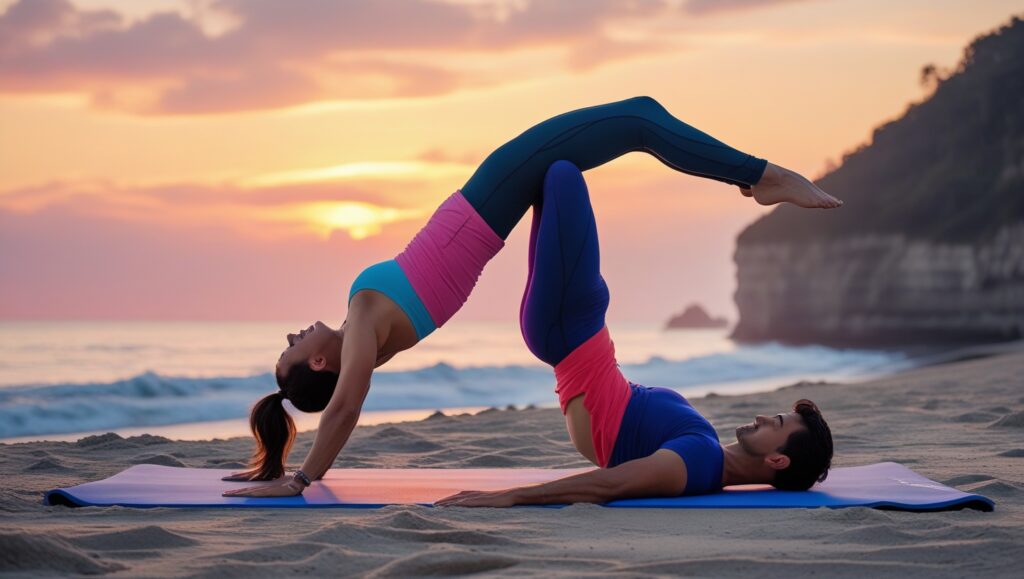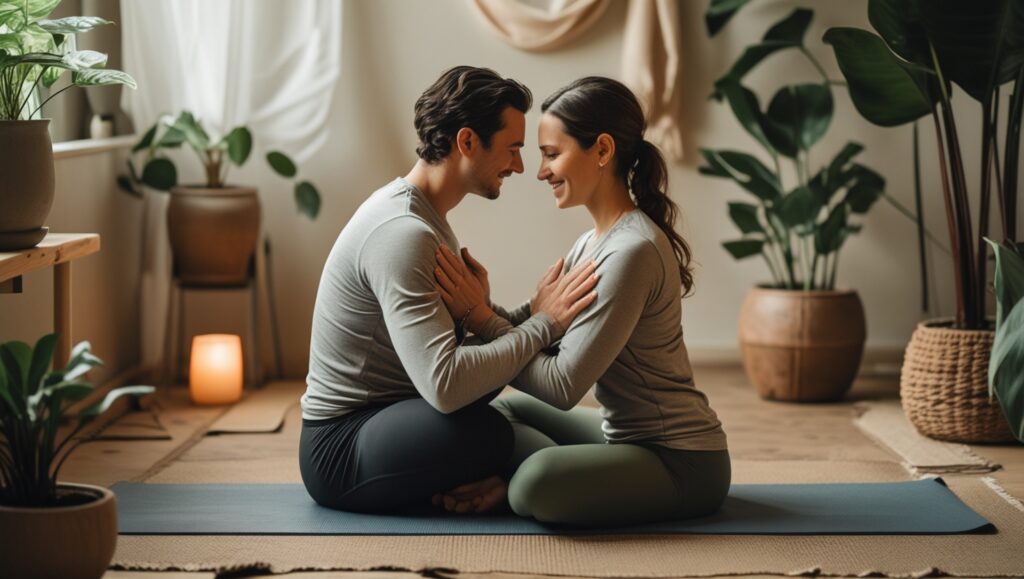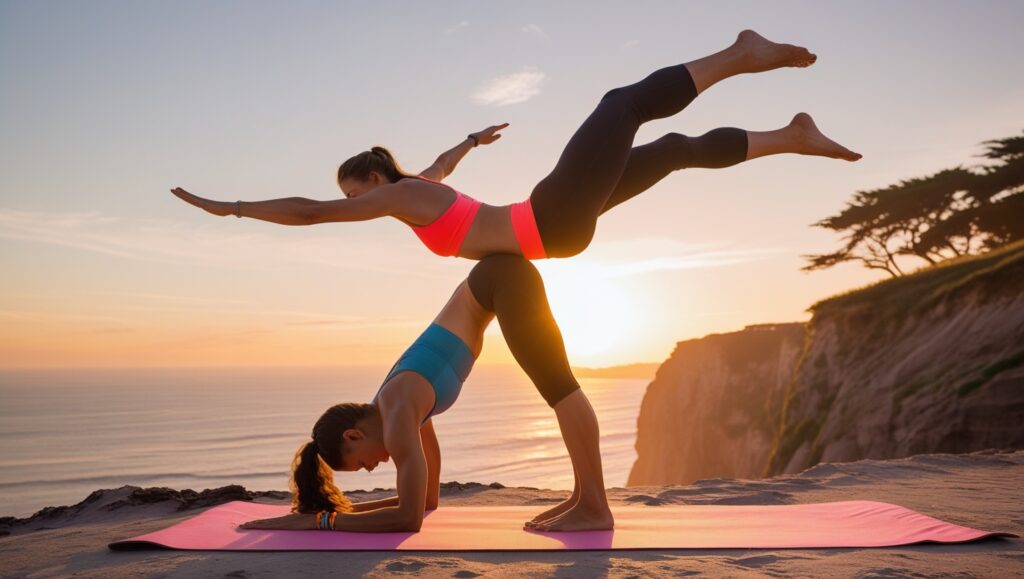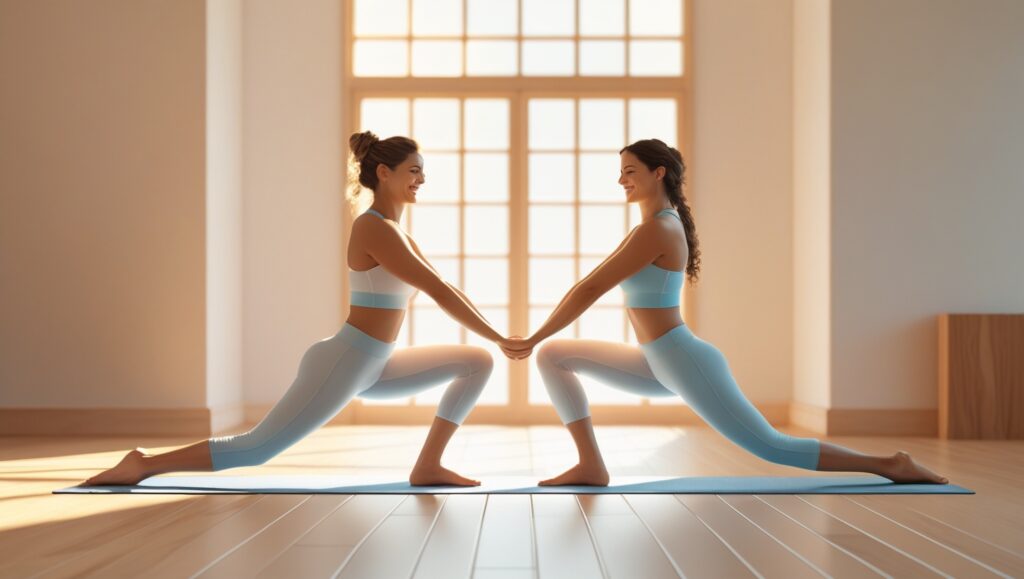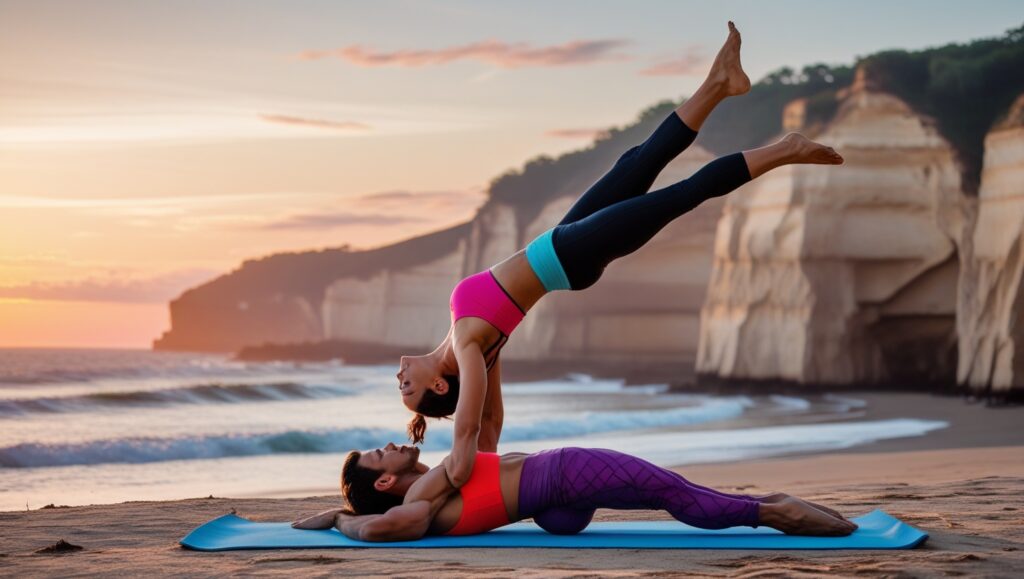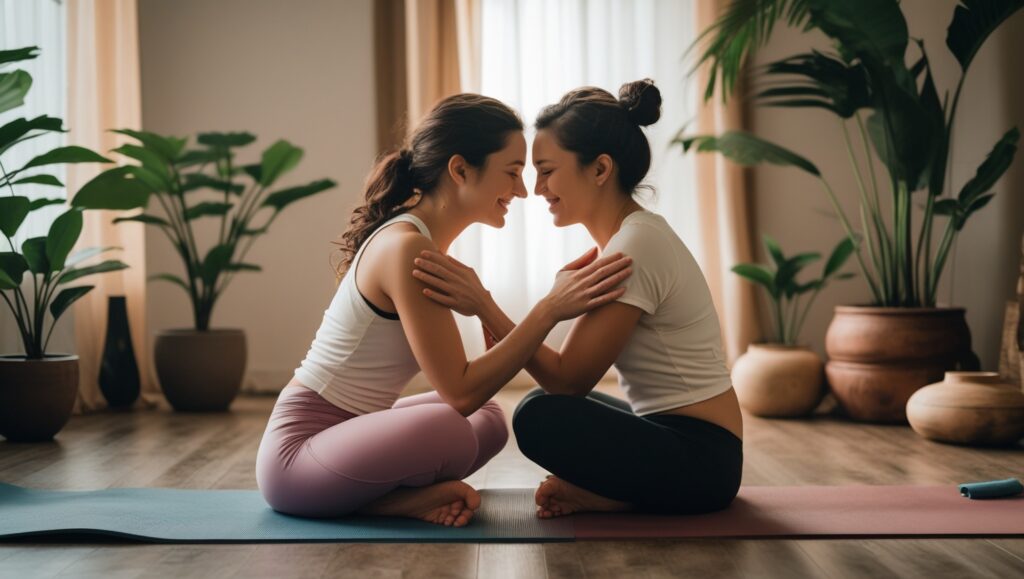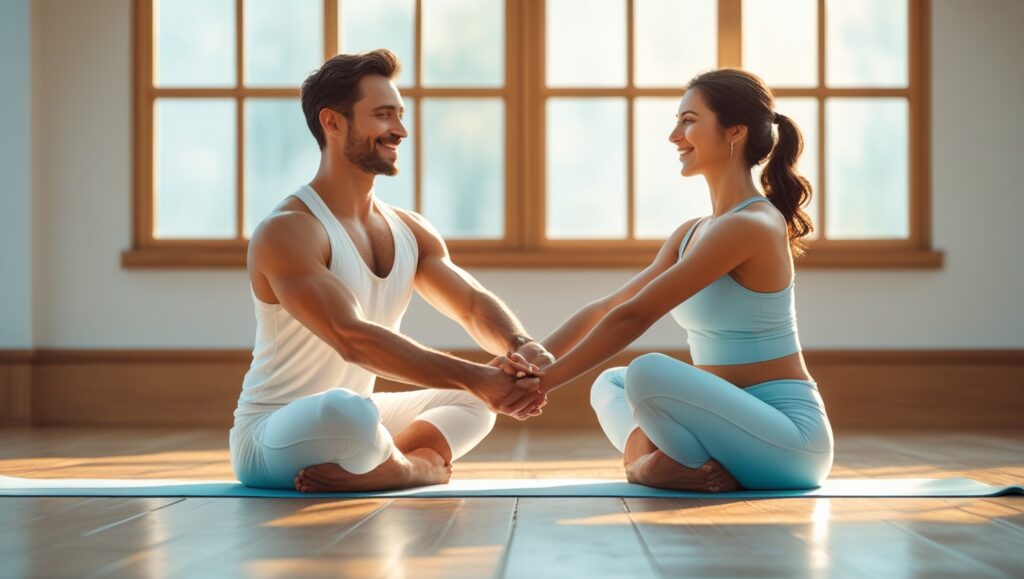Practicing Partner Yoga Poses offers more than just physical benefits—it fosters trust, builds deeper emotional bonds, and enhances mindfulness. Whether you’re doing yoga with a friend, spouse, or fellow practitioner, these partner yoga poses are perfect for increasing flexibility, alignment, and shared energy. This guide, crafted with care and real-world yoga insights, will help you explore the joy of moving together in harmony.
Partner yoga poses doesn’t require extreme athleticism; it only requires trust, communication, and presence. Let’s dive into the top 15 poses that blend connection with flexibility, inspired by real experiences and mindful instruction.
Partner Yoga Poses
Table of Contents
1. Seated Breathing Meditation (Partner Pranayama)
Start with stillness. Sit cross-legged, back to back. Align your spines and close your eyes. Begin deep breathing—inhale and exhale slowly, trying to match each other’s rhythm.
Benefits:
- Enhances breath awareness
- Builds energetic connection
- Grounds both partners before active poses
This mindful start sets the tone for mutual trust and connection, essential in partner yoga.
2. Seated Twist
Remain in the same back-to-back seated position. As one partner twists to the right, the other twists to the left, holding each other’s opposite knee and hand behind the back.
Benefits:
- Improves spinal mobility
- Promotes mirrored movement awareness
- Eases tension from the lower back
A gentle way to explore opposing movements in sync.
3. Partner Forward Fold
Sit facing each other with legs extended and feet touching. Hold each other’s hands. One partner gently pulls the other forward into a fold, then switch.
Benefits:
- Stretches hamstrings and lower back
- Improves flexibility safely
- Encourages surrender and trust
Great for beginners and seasoned yogis alike.
4. Twin Tree Pose
Stand side-by-side, hips touching. Each partner lifts the inside leg and places the sole on the opposite thigh or calf, then join hands or wrap arms around each other’s waist.
Benefits:
- Enhances balance
- Strengthens legs and core
- Deepens partner alignment
Focus your gaze (drishti) ahead to maintain steadiness.
5. Back-to-Back Chair Pose
Stand back-to-back, link arms, and slowly squat down into a chair position. Press your backs firmly together for support.
Benefits:
- Strengthens thighs and glutes
- Builds team effort
- Cultivates endurance and balance
This pose promotes clear communication and coordination.
6. Partner Cat-Cow Stretch
Come into a tabletop position, facing your partner. Sync your breath as you alternate between arching (cow) and rounding (cat) your spines. You can gently mirror each other’s movement by touching palms or foreheads.
Benefits:
- Mobilizes the spine
- Enhances rhythm and flow
- Encourages mutual breath awareness
Ideal as a gentle warm-up or cooldown.
7. Double Downward Dog
One partner starts in Downward Dog. The second partner places hands in front of the first and walks feet onto their back, creating a two-tiered version of the pose.
Benefits:
- Strengthens shoulders and arms
- Builds core stability
- Increases trust and communication
Move carefully and only try this once both partners feel confident.
8. Double Plank
Begin in a standard plank. The second partner carefully places their hands on the lower back of the first partner and stacks their feet on the shoulders.
Benefits:
- Boosts upper body and core strength
- Promotes balance
- Engages every muscle group
This pose is perfect for building strength together.
9. Partner Boat Pose (Navasana)
Sit facing each other, knees bent, toes touching. Hold hands and lift your legs, pressing soles together to form a “V.”
Benefits:
- Tones abs and hip flexors
- Improves posture
- Encourages laughter and lightness
Balance and coordination meet playful challenge here.
10. Partner Cobra Pose
Lie on your stomachs, side by side. Reach across and hold each other’s hands. Inhale as you both rise into Cobra, gently lifting your chest while anchoring through the pelvis.
Benefits:
- Opens the chest
- Strengthens lower back
- Deepens heart connection
Move with breath and intention for best results.
11. Flying Superman
Partner A lies on the ground and lifts Partner B with their feet (under the hips). The flier extends arms like Superman while balancing mid-air.
Benefits:
- Builds trust
- Enhances balance and strength
- Feels exhilarating!
Start with assistance or a spotter if you’re new to Acro-style lifts.
12. Partner Forward Bend & Backbend
Stand facing each other. One partner folds forward while the other leans back, resting on the arms of the forward bender.
Benefits:
- Provides deep stretch for both
- Enhances spinal flexibility
- Encourages supportive movement
A beautiful balance of surrender and strength.
13. Double Child’s Pose
Sit back to back in Child’s Pose, then slowly reach your arms overhead to rest on each other’s backs.
Benefits:
- Calms the nervous system
- Gently stretches the shoulders and back
- Fosters restful connection
Use this pose to ground your practice near the end.
14. Partner Savasana
Lie down next to each other or with heads touching and arms lightly connected. Close your eyes and rest together in stillness.
Benefits:
- Deep relaxation
- Integration of practice
- Emotional connection
Stay for at least 5 minutes in silence.
15. Heart-to-Heart Seated Hug
End your session seated, facing each other. Place your right hand on your partner’s heart, left hand on your own heart, and breathe together. Share a final embrace if comfortable.
Benefits:
- Builds emotional intimacy
- Enhances gratitude
- Creates a meaningful close
This final moment reminds you that yoga is more than poses—it’s about presence.
Conclusion:
Partner yoga poses is more than a shared workout—it’s a journey of connection, communication, and mutual growth. By practicing these 15 partner yoga poses, you not only enhance flexibility and strength but also cultivate trust, presence, and emotional bonding. Whether you’re looking to deepen a romantic relationship, strengthen a friendship, or simply add variety to your yoga routine, partner yoga offers a meaningful path forward. Embrace the process, move mindfully, and let your shared breath guide you toward greater harmony—on and off the mat.
Ready to take your wellness journey to the next level? Stay tuned to our blog for more evidence-based tips, practical guides, and holistic health insights. If you found this article helpful, don’t forget to share it with friends or leave a comment below — your support helps us reach more readers like you. Let’s build a healthier, stronger you — one day at a time.
About the Author
V. Murali Krishna is a passionate wellness educator with over 15 years of experience in fitness, yoga, and holistic health. While not a certified coach, his in-depth knowledge and hands-on experience bring practical insights to help readers lead a healthy lifestyle.
Which pose is queen of yoga?
The “Shoulder Stand” (Sarvangasana) is often referred to as the queen of yoga poses. It benefits the thyroid, improves circulation, and calms the nervous system. However, in partner yoga, there’s no single “queen”—each pose offers a unique way to connect, stretch, and build trust.
What is the difference between partner yoga and Acro Yoga?
Partner yoga focuses on mutual support, stretching, and grounding. It emphasizes synchronization and emotional connection. Acro Yoga combines yoga with acrobatics—often including lifts, balances, and more dynamic movement. While both involve trust and collaboration, Acro Yoga is more physically demanding and performance-based.

